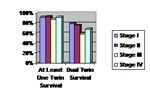Understanding Outcomes Associated With Laser Surgical Treatment of TTTS
Twin-twin transfusion syndrome (TTTS) affects approximately 10% of twins that share the same placenta. The preferential shunting of blood from one twin to the other twin causes such hemodynamic alternations as twin oligohydramnios, recipient twin polyhydramnios, recipient twin polyhydramnios, and characteristic anatomical and arterial/venous flow abnormalities.
Twin-twin transfusion syndrome (TTTS) affects approximately 10% of twins that share the same placenta. The preferential shunting of blood from one twin to the other twin causes such hemodynamic alternations as twin oligohydramnios, recipient twin polyhydramnios, recipient twin polyhydramnios, and characteristic anatomical and arterial/venous flow abnormalities. Studies have shown that selective laser photocoagulation of communicating vessels (SLPCV) is the optimal treatment, with survival rates for at least one twin ranging from 65% to 93% and survival rates for both twins ranging from 18% to 62%. To facilitate patient selection and counseling, Dr Ramen H. Chmait, assistant professor of clinical obstetrics and gynecology in the division of maternal-fetal medicine and director of the Fetal Therapy Program at the University of Southern California's Keck School of Medicine, and colleagues sought to better understand perinatal outcomes of laser-treated patients according to Quintero stage.
Chmait and colleagues conducted a prospective study of all patients undergoing laser treatment for TTTS at USFetus Centers (the University of Miami and University of Southern California Fetal Therapy Programs). The researchers enrolled 682 consecutive women. At initial assessment, patients received a complete ultrasonographic examination; pregnancies that resulted in TTTS diagnoses were also classified according to the Quintero staging system. If they were diagnosed with TTTS between 16 and 26 weeks’ gestation, patients were offered laser therapy and were counseled regarding alternative management options. Breakdown of stages can be found in the Figure 1.
Figure 1. Breakdown of patients by Quintero stage.

Mean gestational age at delivery was similar regardless of stage. Donor twin intrauterine growth restriction was higher in patients in stage III as compared to those patients in stage I, II, and IV. While survival of at least one twin at day 30 did not differ based on stage, dual twin survival was different among the stages, with patients in stage III seeing a relative significant decrease in dual twin survival (Figure 2). Chmait and colleagues also noted a positive impact of using the sequential SLPCV procedure; after controlling for stage, study center, and donor twin intrauterine growth restriction, patients undergoing the sequential procedure were nearly twice as likely as those who did not to exhibit dual survival at 30 days. However, the researchers cautioned that although this result is encouraging, there were difficulties associated with these patients that prevented them from having sequential SLPCV and that may have impacted their overall outcomes.
Figure 2. Twin survival rates by stage.

“We believe that survival rates after laser treatment do not exhibit progressive decline with advancing Quintero stage because this system classifies gestations based on the severity of the twins’ preoperative condition, which is in large part induced by the vascular communications within the placenta,” the researchers explained. “On the basis of the available data, we recommend offering laser surgery to patients with TTTS regardless of Quintero stage.”
More Information
USFetusInstitute for Maternal Fetal Health: Diagnosis and Staging of TTTS
Reference
Chmait RH, Kontopoulos EV, Korst LM, et al. Stage-based outcomes of 682 consecutive cases of twin-twin transfusion syndrome treated with laser surgery: the USFetus experience. Am J Obstet Gynecol. 2011 Mar 14 [Epub].
Identifying gaps in syphilis treatment and prenatal care among pregnant individuals
May 17th 2024Preventing congenital syphilis comes down to quick diagnosis and treatment of the infection in pregnancy, and the number of missed opportunities to do so in the United States continues to grow.
Read More
Study reveals critical gaps in care for PCOS patients
May 17th 2024A new study presented at the 2024 ACOG Annual Clinical and Scientific Meeting highlighted significant gaps in polycystic ovary syndrome (PCOS) care, revealing widespread patient dissatisfaction and the urgent need for improved provider education and comprehensive treatment approaches.
Read More
